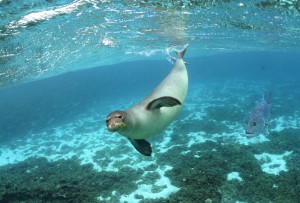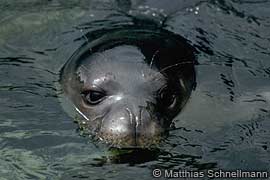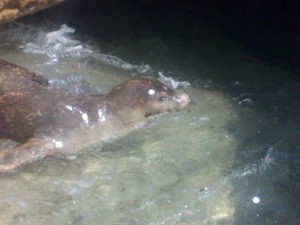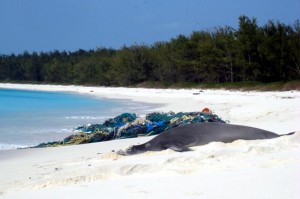On 26 May 2011, a Mediterranean monk seal mother and her pup visited the harbour of Aegiali, on the Cycaldic island of Amorgos. “They stayed there for around three hours,” reports Amorgos Island Magazine, were extremely friendly and played with people on Aegiali Beach.”
Desperate times, desperate measures…
Media Watch, The Huffington Post (Audry McAvoy, Associated Press), 21 May 2011

Federal biologists scouring for ways to spare the critically endangered Hawaiian monk seal from extinction are embracing a desperate if unorthodox strategy: They want to pluck seal pups from the small, pristine island atolls where they’re born and move them closer to Honolulu and other highly populated areas.
Scientists say this counterintuitive step is needed to help save a species that’s declining at a rate of 4 percent annually. But it is already proving to be controversial, and even unpopular among fishermen who don’t want hungry seals eating their bait and accidentally getting caught in their nets and lines.
The National Marine Fisheries Service plans to formally propose the “translocation” of the seals in July, The Associated Press has learned. It wants to bring a few recently weaned female pups to the main Hawaiian Islands each year, keep them here until they’re three years old, and then send them back to the Northwestern Hawaiian Islands.
“We’re desperate. That’s the bottom line. We’re watching this species just crash right in front of our eyes. This is really one of the few things that we think has a chance of making a difference,” said Jeff Walters, the agency’s Hawaiian monk seal recovery coordinator. […Continues…]
Source: Feds aim to save Hawaiian monk seal, The Huffington Post (Audry McAvoy, Associated Press), 21 May 2011
Identification of ciguatoxins in Hawaiian monk seals
Recent Publications
Marie-Yasmine Dechraoui Bottein, Lizabeth Kashinsky, Zhihong Wang, Charles Littnan, and John S. Ramsdell. 2011. Identification of Ciguatoxins in Hawaiian Monk Seals Monachus schauinslandi from the Northwestern and Main Hawaiian Islands. Environmental Science & Technology. DOI: 10.1021/es2002887. [Abstract]
Hundreds of species face extinction across Europe in ‘crisis of biodiversity’
Media Watch, Mail Online, 17 May 2011
 Hundreds of species are facing extinction across Europe in a ‘crisis of biodiversity’.
Hundreds of species are facing extinction across Europe in a ‘crisis of biodiversity’.
According to the EU’s Environment Commissioner Janez Potocnik, animals such as the Iberian lynx, the Mediterranean monk seal and the Bavarian pine vole could soon be gone.
These are among hundreds of species – up to a quarter of the total native to the continent – that are threatened with extinction according to a warning issued this month by the European Union.
‘Biodiversity is in crisis, with species extinctions running at unparalleled rates,’ said a statement from Mr Potocnik.
The threatened species include mammals, amphibians, reptiles, birds and butterflies and plant life is also under threat.
The crisis is due to several factors, including loss of habitat, pollution, alien species encroachment, climate change and overfishing.
Critics say the EU’s proposed solutions don’t go far enough and lack funding. […Continues…]
Source: Hundreds of species face extinction across Europe in ‘crisis of biodiversity’, Mail Online, 17 May 2011.
Monk seal sightings in Egypt
— Giuseppe Notarbartolo di Sciara, Tethys Research Institute, Milano, Italy
— Mahmoud Fouad, Egyptian Environmental Affairs Agency, Cairo, Egypt

On 7 April, during a recent trip along Egypt’s Mediterranean coast to establish stakeholder contacts in implementing a National Action Plan for the Conservation of Cetaceans in that country, funded by the Regional Activity Centre for Specially Protected Areas (RAC/SPA) of Tunis, we were informed by the local community of Marsa Matrouh of a spate of monk seal sightings in the area. The news had generated considerable excitement, since the species has long been considered extinct in Egypt.
In a meeting at the offices of the Director of Environmental Affairs of the Marsa Matrouh Governorate, fishermen reported that seals had been observed several times during the previous 10 days. Mr. Abd El Malek in particular, a fisherman about 60 years old, was very clear. He had begun noticing that something was pulling fish out of his trammel nets, “in a very professional way”, i.e. without breaking the mesh. His boys had told him that they had seen a very strange animal around the nets, similar to those they had watched on TV, in the “yellow square” (National Geographic) eating penguins under the ice. At first he didn’t believe them: throughout his life, he’d never seen a seal in these waters; other fishermen said the same. After several attempts, however, they indeed caught a glimpse of a seal resting on one of the small sandy beaches along the local rocky coastline, and managed to take a few pictures and even a short video with their cell phones. Other fishermen agreed, asserting that they had frequently seen up to five seals during the same period, in a location about 5 km away from the first, and that their nets had been completely destroyed.
Field camps established to determine tsunami impacts on Hawaiian monk seals
Papahānaumokuākea Marine National Monument News Release, 25 April 2011

(Honolulu, HI) NOAA Ship Oscar Elton Sette returned to port at Ford Island/Pearl Harbor on April 22, 2011 after a multi-faceted mission to Papahānaumokuākea Marine National Monument in the Northwestern Hawaiian Islands. Directed by NOAA’s Pacific Islands Fisheries Science Center (PIFSC), one of the cruise’s primary goals was to establish five field camps and deploy 14 scientists with the Hawaiian Monk Seal Research Program (HMSRP). Over the course of the next three to four months the researchers will build upon 28 years of field research into the critically endangered Hawaiian monk seal. The population of Hawaiian monk seals is declining about 4% annually, driven largely by poor juvenile survival; with fewer than 1 in 5 pups surviving to become adults in the Northwestern Hawaiian Islands.
Continue reading “Field camps established to determine tsunami impacts on Hawaiian monk seals”
